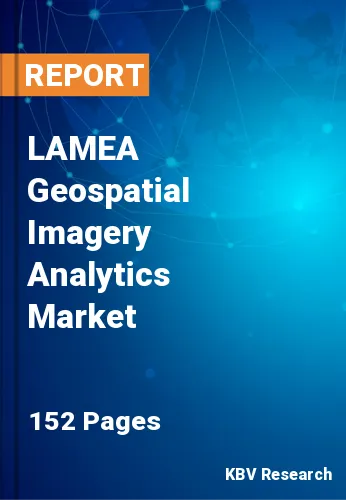The Latin America, Middle East and Africa Geospatial Imagery Analytics Market would witness market growth of 32.8% CAGR during the forecast period (2021-2027).
Geospatial analytics provides context to traditional data by adding timing and place, allowing for a more full view of occurrences. Easy-to-recognize visual patterns and pictures provide insights that could have been buried in a huge spreadsheet. Companies that specialize in geospatial analytics can handle massive volumes of geometric and geographic data in real time. Users may engage with billions of mapped locations while viewing real-time geospatial representations as a result of this. Users may look at data over time and space to understand how something has evolved over time, from days to years.
The profitable growth of the worldwide geospatial imagery analytics market is fueled by the quick advancements that geographical information systems are making in a variety of end-use sectors, particularly catastrophe management. The increasing use of GIS in climate change, carbon management, flood control, and in integrating, analyzing, and finding patterns in geospatial data is a significant element driving the geospatial imagery analytics industry forward.
The market for geospatial imaging analytics is rapidly growing. The expansion of the geospatial imagery analytics market is being fueled by the growth of geographic information systems (GIS) and the integration of geospatial data with mainstream technologies. This explains the steady increase in demand from the mining, building, manufacturing, and engineering industries. Aside from that, the growing need for high-resolution satellite pictures from a variety of end users, as well as the desire for location-based services, is expanding the geospatial imaging analytics market.
Space Imaging Middle East (SIME) is the Middle East's premier geospatial and GIS solution supplier. The use of this technology to track the regional production of illegal crops was a big accomplishment for SIME. Furthermore, commercial satellite imaging is utilized to monitor agricultural productivity in South Africa.
The Brazil market dominated the LAMEA Geospatial Imagery Analytics Market by Country 2020, and would continue to be a dominant market till 2027; thereby, achieving a market value of $813.5 million by 2027. The Argentina market is poised to grow at a CAGR of 33.5% during (2021 - 2027). Additionally, The UAE market would display a CAGR of 32.5% during (2021 - 2027).
Based on Type, the market is segmented into Image-based Analytics and Video Analytics. Based on Vertical, the market is segmented into Defense & Security, Engineering & Construction, Mining & Manufacturing, Government, Environmental Monitoring, Healthcare & Life Sciences, and Agriculture. Based on Collection Medium, the market is segmented into Geographic Information System (GIS) and Satellites. Based on Deployment Type, the market is segmented into On-premise and Cloud. Based on Organization Size, the market is segmented into Large Enterprises and Small & Medium Enterprises. Based on Application, the market is segmented into Disaster Management, Construction & Development, Conservation & Research, Exhibition & Live Entertainment and Surveillance & Monitoring. Based on countries, the market is segmented into Brazil, Argentina, UAE, Saudi Arabia, South Africa, Nigeria, and Rest of LAMEA.
Free Valuable Insights: The Global Geospatial Imagery Analytics Market is Predict to reach $42.2 Billion by 2027, at a CAGR of 29.5%
The market research report covers the analysis of key stake holders of the market. Key companies profiled in the report include Trimble, Inc., Microsoft Corporation, Google LLC, TomTom N.V., Hexagon AB, L3Harris Technologies, Inc., Planet Labs, Inc., Oracle Corporation, Alteryx, Inc.
By Type
By Vertical
By Collection Medium
By Deployment
By Organization Size
By Application
By Country
Our team of dedicated experts can provide you with attractive expansion opportunities for your business.

